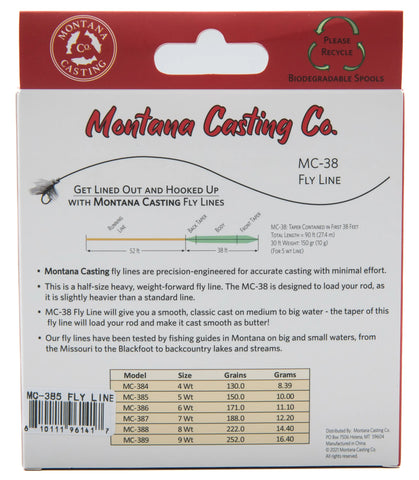Digging into Fly Line Taper
In Fly Lines Part 1, we looked at how a rod’s optimal line weight is determined using the Common Cents System as well as how additional factors (such as target species, weather conditions, and casting ability) might influence which line weight is right for you. This week’s post is all about taper. What is it? How does it vary across fly lines? Why do we care? Let’s jump back into the weeds!
What is taper?
In generic terms, taper refers to the shape of a fly line. Fly line shape (or diameter) usually varies throughout the length of the line. There are a few key components to a fly lines’ taper: the belly (where most of the mass is located), the front taper (the transition between the tip of the line and the belly), and the rear taper (the transition from the belly of the line to the running line). Varying the length and diameter of these different components allows for the creation of specialized fly lines.

Nowadays, there are several types of tapered fly lines, including weight-forward, double taper, shooting taper, and level line. Weight-forward fly lines are arguably the most popular, but we’ll also touch briefly on double taper lines.
What is a double taper fly line?
Double taper lines have a belly section that takes up most of the length of the fly line. The front and rear tapers are uniform in length and profile, and the middle of the taper is the exact center of the fly line. The idea behind this was to make your fly line last longer; once you wear out one side of the fly line, you can flip the line and use the back half just like a new fly line. Though they lack the direct power of weight forward lines, their longer, thinner tip section makes them ideal for delicate, dry fly presentations.
What is a weight forward fly line?
All Montana Casting Co. fly lines are designed with weight-forward tapers. As the name suggests, weight-forward lines are designed to carry most of the mass in the head of the line. A shorter, heavier belly pulls the comparatively light “running line” (or uniform, non-tapered section) forward. This makes it easier to shoot line over long distances, through windy conditions, or with a heavier, more air-resistant fly.
When you’re shopping around for a weight forward fly line, you’ll find differences in the lengths of the front and rear tapers as well as the belly sections. These factors influence the accuracy, presentation, line control, and the overall aggressiveness of the line. Choosing the right weight forward line is often a matter of determining what balance of these features is best for the conditions you’ll be fishing in.
For example, you might be fishing a fast-action fly rod on small rivers or creeks. You’re making short casts—30 feet or less. A shorter, more aggressive, weight-forward tapper will allow you to feel the rod load.
If you’re fishing a buttery-smooth, medium action and you’re float-tubing on a lake, you’ll want a longer tapered head to allow for longer casts and to help prevent your line from slapping the water behind you.
Or maybe you’re fishing with Montana Casting Co.’s “Old Blue” (the Warm Springs) and you’re looking to use it on everything from gurgling mountain creeks to big rivers and wide-open lakes. If you have a favorite rod, you’ll want to bring it everywhere—and that means you’ll want a medium taper line that can handle a variety of situations.
How can you tell what the taper of the fly line you're looking at is?
Most modern fly lines have specifications online or on the packaging that inform you how long the tapper is and the weight in grains of the first 30 feet of the fly line (minus the level line). You might also see abbreviations (such as WF for weight forward lines) that tell you more about the lines. Here’s an example of what you will find on the packaging of a Montana Casting Co. fly line:

The final post in our three-part series on fly lines will cover Montana Casting Co. fly lines. We’ll talk design process, key differences, and how to decide which MCCo. line is right for your upcoming fly fishing adventures.
Disclaimer: Yes, we’ve mercilessly dissected and weighed many fly lines over the years to get our fly rods and fly lines to be exactly what we want them to be. I know it's terrible, but it was done in the name of science!
We’d love to answer any of your fly fishing related questions! Leave a comment below, send us an email at gethookedup@montanacastingco.com, or give us a call at 406-285-1452. Happy fishing!










0 comments